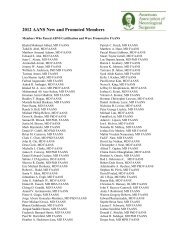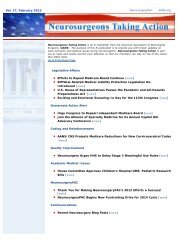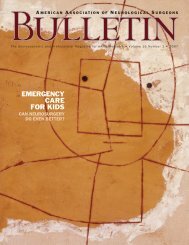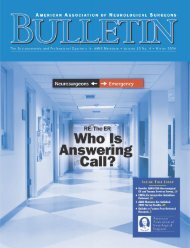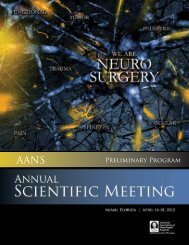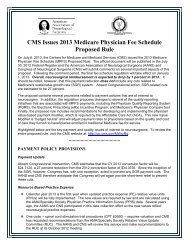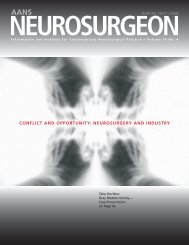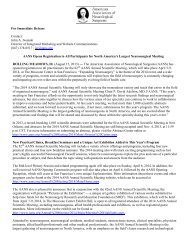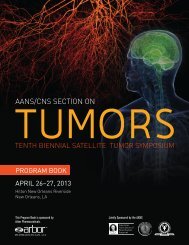view PDF - American Association of Neurological Surgeons
view PDF - American Association of Neurological Surgeons
view PDF - American Association of Neurological Surgeons
Create successful ePaper yourself
Turn your PDF publications into a flip-book with our unique Google optimized e-Paper software.
On The Cover: Time Tells<br />
FIGURE 1<br />
Chief Resident Operative Cases Before and After ACGME Resident<br />
Work Hour Restrictions<br />
Percent <strong>of</strong><br />
“Resident<br />
Present” Cases<br />
Covered by<br />
Chief Resident<br />
90.2%<br />
2002-2003<br />
Total No. Chief Resident Cases: 1,312<br />
81.5%<br />
2003-2004<br />
Total No. Chief Resident Cases: 1,041<br />
before the critical portion <strong>of</strong> the operation was<br />
accomplished. At this time the long-term effects <strong>of</strong><br />
decreased operative exposure are not known.<br />
Clearly more research must be done, especially<br />
regarding the impact that the work hour restrictions<br />
will have on those currently in neurosurgical training.<br />
The restricted hours simply have not been in<br />
place long enough for their impact on lengthy training<br />
programs such as neurosurgery’s to be fully realized.<br />
While it is apparent that many in our field do<br />
not agree with these rules, it is imperative that further<br />
study be carried out to ensure that trainees graduating<br />
from neurosurgical residency are equipped to<br />
operate in this most challenging specialty. 3<br />
Percent <strong>of</strong><br />
Total Cases<br />
Covered by 81.9%<br />
68.6%<br />
Chief<br />
Resident<br />
2002-2003<br />
Total No. Chief Resident Cases: 1,312<br />
2003-2004<br />
Total No. Chief Resident Cases: 1,041<br />
Continued from page 15<br />
potential piece <strong>of</strong> information that would make the<br />
data more robust. We also have made no attempt to<br />
determine whether the personal preferences <strong>of</strong> the<br />
chief residents for certain cases over others may have<br />
falsely elevated or decreased their numbers. Also,<br />
although every measure was taken to ensure accurate<br />
recording, no guarantee can be made that the systems<br />
used for recording data are without flaws.<br />
Conclusions<br />
This study examined the feasibility <strong>of</strong> working within<br />
the ACGME-mandated guidelines and the effect<br />
that the presumably reduced time at work had on<br />
resident surgical exposure. The results clearly show<br />
that even in a one-resident-per-year program covering<br />
four hospitals, compliance can be achieved. This<br />
compliance, however, was not achieved without significant<br />
changes to the resident operative experience.<br />
The percentage <strong>of</strong> cases not covered by residents<br />
increased, and further examination revealed that the<br />
operative experience <strong>of</strong> the chief residents dropped<br />
significantly. These numbers are conservative estimates.<br />
No account can be made for residents who<br />
may have had to leave the case before completion or<br />
REFERENCES<br />
1. Bland KI, Stoll DA, Richardson JD, Britt LD: Brief communication<br />
<strong>of</strong> the Residency Re<strong>view</strong> Committee-Surgery (RRC-S) on<br />
residents’ surgical volume in general surgery. Am J Surg<br />
190(3):345–350, 2005<br />
2. Brasel KJ, Pierre AL, Weigelt JA: Resident work hours: what they<br />
are really doing. Arch Surg 139(5):490–493; discussion 493–494,<br />
2004<br />
3. Breen E, Irani JL, Mello MM, Whang EE, Zinner MJ, Ashley SW:<br />
The future <strong>of</strong> surgery: today’s residents speak. Curr Surg<br />
62(5):543–546, 2005<br />
4. Cohen-Gadol AA, Piepgras DG, Krishnamurthy S, Fessler RD:<br />
Resident duty hours reform: results <strong>of</strong> a national survey <strong>of</strong> the<br />
program directors and residents in neurosurgery training programs.<br />
Neurosurgery 56(2):398–403; discussion 398–403, 2005<br />
5. Friedman WA: Resident duty hours in <strong>American</strong> neurosurgery.<br />
Neurosurgery 54(4):925–931; discussion 931–933, 2004<br />
6. Gelfand DV, Podnos YD, Carmichael JC, Saltzman DJ, Wilson<br />
SE, Williams RA: Effect <strong>of</strong> the 80-hour workweek on resident<br />
burnout. Arch Surg 139(9):933–938; discussion 938–944, 2004<br />
7. Irani JL, Mello MM, Ashley SW, Whang EE, Zinner MJ, Breen E:<br />
Surgical residents’ perceptions <strong>of</strong> the effects <strong>of</strong> the ACGME duty<br />
hour requirements 1 year after implementation. Surgery<br />
138(2):246–253, 2005<br />
8. Kupferman TA, Lian TS: Implementation <strong>of</strong> duty hour standards<br />
in otolaryngology-head and neck surgery residency training.<br />
Otolaryngol Head Neck Surg 132(6):819–822, 2005<br />
9. Lowenstein J: Where have all the giants gone Reconciling medical<br />
education and the traditions <strong>of</strong> patient care with limitations<br />
on resident work hours. Perspect Biol Med 46(2):273–282, 2003<br />
10. Reiter ER, Wong DR: Impact <strong>of</strong> duty hour limits on resident<br />
training in otolaryngology. Laryngoscope 115(5):773–779, 2005<br />
11. Spencer AU, Teitelbaum DH: Impact <strong>of</strong> work-hour restrictions<br />
on residents’ operative volume on a subspecialty surgical service.<br />
J Am Coll Surg 200(5):670–676, 2005<br />
12. Underwood W, Boyd AJ, Fletcher KE, Lypson ML: Viewpoints<br />
from generation X: a survey <strong>of</strong> candidate and associate <strong>view</strong>points<br />
on resident duty-hour regulations. J Am Coll Surg<br />
198(6):989–993, 2004<br />
13. Whang EE, Mello MM, Ashley SW, Zinner MJ: Implementing<br />
resident work hour limitations: lessons from the New York State<br />
experience. Ann Surg 237(4):449–455, 2003<br />
14. Whang EE, Perez A, Ito H, Mello MM, Ashley SW, Zinner MJ:<br />
Work hours reform: perceptions and desires <strong>of</strong> contemporary<br />
surgical residents. J Am Coll Surg 197(4):624–630, 2003<br />
16 AANS Bulletin • www.AANS.org



